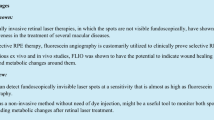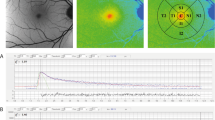Abstract
Purpose. Daunorubicin is a cytotoxic drug, which, in nontoxic doses, is effective in preventing cellular proliferation in experimental vitreoretinopathy. We studied dose and clearance of daunorubicin in various ocular tissues using fluorophotometry techniques. Methods. In vitro tests: The emission of fluorescence from the daunorubicin solution having a concentration range of 0.1 to 10 μg/mL in phosphate buffer was measured using an excitation wavelength range of 489 ± 10 nm. The emission of fluorescence was measured at 514 nm; the linearity of the response was determined using linear regression analysis. There is a fluorescence peak of daunorubicin at 485 nm. The validity and reproducibility of the method were examined. In vivo tests: The rabbits were randomized into three groups and daunorubicin concentrations of 4, 6, or 8 μg/mL were injected into the vitreous. Fluorophotometry scanning from the retina to the anterior chamber was performed with a commercially available fluorophotometer at various times up to 48 hours after injection to quantify fluorescence emission of daunorubicin. Results. The standard curve of fluorescence versus concentration of daunorubicin was linear in the range of 0.1 to 8 μg/mL. It was sensitive up to 0.1 μg. The daunorubicin time concentration profile showed a dose response relationship over the 48-hour period studied. The half-life of daunorubicin in the vitreous was about 5 hours. Conclusion. We performed fluorophotometry using a fluorophotometer whose exciter emits light at 489 nm, which is very close to an absorption peak of daunorubicin. These two values are close enough to obviate the need for modifying the commercial fluorophotometer. Therefore the concentration of daunorubicin in the vitreous cavity can be measured noninvasively.
Similar content being viewed by others
References
Machemer, R. Pathogenesis and classification of massive periretinal proliferation. Br J Ophthalmol 1978; 62: 737–47.
Machemer, R. Massive periretinal proliferation. A logical approach to therapy. Trans Am Ophthalmol Soc 1977; 75: 556–86.
Kirmani, M, Santana, M, Sorgente, N, Wiedemann, P, Ryan, SJ. Antiproliferative drugs in the treatment of experimental proliferative vitreoretinopathy: control by daunomycin. Retina 1983; 3: 269–72.
Khawly, JA, Saloupis, P, Hatchell, DL, Machemer, R. Daunorubicin treatment in a refined experimental model of proliferative vitreoretinopathy. Graefes Arch Clin Exp Ophthalmol 1991; 229: 464–7.
Wiedemann, P, Leinung, C, Hilgers, R-D, Heimann, K. Daunomycin and silicone oil for the treatment of proliferative vitreoretinopathy. Graefes Arch Clin Exp Ophthalmol 1991; 229: 150–2.
Myers, C, Simone, C, Gianni, R, Greene, R, Klecker, R, Hendrickson, M. The role of doxorubicin-iron complex in superoxide production and membrane damage (abstr). Proceedings of the American Association of Cancer Research 1981; 22: 28.
Patel, DJ, Canuel, LL. Anthracycline antitumor antibiotic nucleic acid interactions. Structural aspects of the daunomycin-poly (dA-dT) complex in solution. Eur J Biochem 1978; 90: 247–54.
Handa, K, Sato, S. Generation of free radicals of quinone group-containing anti-cancer chemicals in NADPH-microsome system as evidenced by initiation of sulfite oxidation. Gann 1975; 66: 43–7.
Handa, K, Sato, S. Stimulation of microsomal NADPH oxidation by quinone group-containing anticancer chemicals. Gann 1976; 67: 523–8.
Sato, S, Iwaizumi, M, Handa, K, Tamura, Y. Electron spin resonance study on the mode of generation of free radicals of daunomycin, adriamycin and carboquinone in the NAD(P)H microsome system. Gann 1977; 68: 603–8.
Duarte-Karim, M, Ruysschaert, JM, Hildebrand, J. Affinity of adriamycin to phospholipids: a possible explanation for cardiac mitochondrial lesion. Biochem Biophys Res Commun 1976; 71: 658–63.
Santana, M, Wiedemann, P, Kirmani, M, Minckler, DS, Patterson, R, Sorgente, N, et al. Daunomycin in the treatment of experimental proliferative vitreoretinopathy: retinal toxicity of intravitreal daunomycin in the rabbit. Graefes Arch Clin Exp Ophthalmol 1984; 221: 210–3.
Steinhorst, UH, Hatchell, DL, Chen, EP, Machemer, R. Ocular toxicity of subdivided doses on the rabbit retina after vitreous gas compression. Graefes Arch Clin Exp Ophthalmol 1993; 231: 591–4.
Author information
Authors and Affiliations
Additional information
Supported in part by U.S. Public Health Service grants EY07541, EY08137, and EY02377 from the National Eye Institute, National Institutes of Health, Bethesda, MD, USA.
Rights and permissions
About this article
Cite this article
Kizhakkethara, I., Li, X., El-Sayed, S. et al. Noninvasive monitoring of intraocular pharmacokinetics of daunorubicin using fluorophotometry. Int Ophthalmol 19, 363–367 (1995). https://doi.org/10.1007/BF00130856
Accepted:
Issue Date:
DOI: https://doi.org/10.1007/BF00130856




